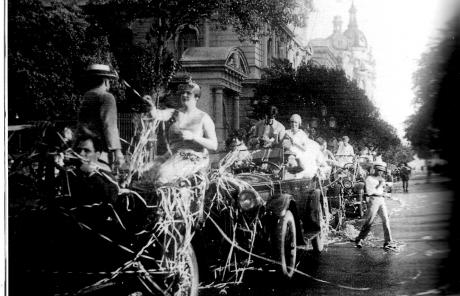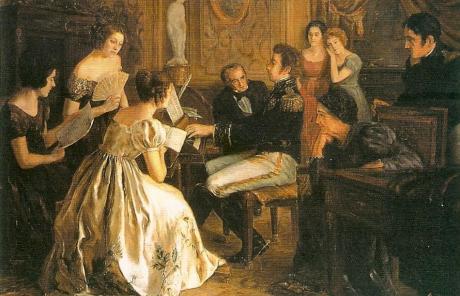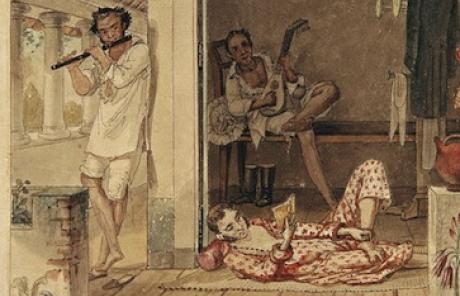1. Colonial period (to 1822).
Relatively little is known about art music activities and composition during the first two centuries of Brazilian history. The substantial documentation attesting to important musical activities in Pernambuco (Olinda, Recife) and Salvador, Bahia, was not compiled and studied until the mid-20th century. Throughout the colonial period most music-making related directly to church services, and surviving colonial music is therefore mainly sacred. The regular clergy was responsible for first organizing Christian religious life in Brazil. The Franciscans started using music in the conversion of the Amerindians, but it was the Jesuits who had the strongest influence on the musical life of the colony, and as early as 1550 the Jesuit Nóbrega had initiated musical instruction at Bahia. Instrument making did not flourish, however, until the 18th century. Organs and other instruments were built in Pernambuco and Minas Gerais.
The first extant colonial composition, a recitative and aria in the vernacular for soprano, first and second violins and continuo, was written at Bahia in 1759, but the attribution of the authorship to Caetano de Mello Jesus, mestre de capela at Bahia Cathedral, appears unfounded. Another early work is a Te Deum (c1760) for mixed chorus and continuo by Luiz Álvares Pinto, a mulatto composer who was mestre de capela at S Pedro dos Clérigos, Recife, and founder in that city of the important Irmandade de S Cecília dos Músicos, a musicians’ guild. In addition, he wrote a theoretical treatise, Arte de solfejar, whose manuscript is in the Biblioteca Nacional, Lisbon.
An exceptional musical life developed during the latter part of the 18th century in Minas Gerais province, in response to the socio-economic boom there. According to the musicologist F.C. Lange, who first uncovered the primary sources of that repertory, there were about 1000 musicians active in Minas Gerais between about 1760 and 1800, particularly in the cities of Vila Rica (now Ouro Preto), Sabará, Mariana, Arraial do Tejuco (now Diamantina) and São João del Rei. Most of them were mulatto and associated with various local brotherhoods (irmandades), musical guilds that were relatively independent of the clergy. Composers whose works are known include Lobo de Mesquita, Coelho Neto, Gomes da Rocha and Parreiras Neves. They all cultivated a prevailingly homophonic style in sacred works for mixed chorus with orchestral accompaniment including violins, viola, horns, occasionally oboes and flutes and continuo. Most of the compositions that have been discovered are liturgical (masses, motets, antiphons, novenas etc.). The only work with a vernacular text is Parreiras Neves’s Oratoria ao Menino Deos para a Noite de Natal (1789), discovered in Mariana in 1967; only its soprano and instrumental bass parts have survived. It is remarkable that this tradition of colonial church music has survived continuously in the city of São João del Rei, with the Orquestra Ribeiro Bastos and the Lira Sanjoanese, thanks to the efforts in the late 20th century of musicologist-conductor José Maria Neves and others. These organizations involve local amateur musicians as vocalists and instrumentalists.
The Bahian Damião Barbosa de Araújo (1778–1856) was an active composer of sacred music and left about 23 works. Of the various mestres de capela at São Paulo Cathedral, André da Silva Gomes was particularly notable, not only as a prolific composer of sacred music but also as an influential teacher. In the interior of the state of São Paulo, the town of Mogi das Cruzes was also a centre of sacred music; the manuscripts of 11 compositions, almost certainly dating from the late 17th and early 18th centuries, were discovered in 1984.
In the early 18th century the musical comedies of Antonio José da Silva (1705–39), nicknamed ‘O Judeu’, enjoyed great success in the colony as well as in Lisbon. Musical life at Rio de Janeiro was greatly stimulated by the transfer to that city of the Portuguese royal court in 1808. In the same year King João VI created the royal chapel to which he appointed as musical director and mestre de capela the mulatto composer Nunes García, who is rightly considered one of Brazil’s finest musicians. 237 of his works are extant, among them a multitude of masses, motets, and pieces for Holy Week and other feast days. His earlier sacred pieces have a devotional character while his later ones, like those of contemporary Europe, show the influence of opera in both choral sections and arias. His Requiem (1816), written on the death of Queen Maria I, and Missa de Santa Cecília (1826) are generally considered his masterpieces.
Professional European composers began to migrate to Brazil during João VI’s residency in Rio de Janeiro. Most notably, the Portuguese opera composer Marcos Portugal settled there in 1811, adding great prestige to the musical life of the city. The Austrian Sigismund Neukomm was employed by the court from 1816 to 1821 to teach the young Prince Pedro; he wrote the Missa para o dia da Aclamação de João VI and earliest known Brazilian piano piece (1819), using a tune from a Brazilian popular song.
2. After independence.
The 19th-century musical scene was dominated by opera and salon music. After independence the former Royal Theatre became the Imperial Theatre. The reign of Pedro II was characterized by the cultivation and official protection of Italian opera; Bellini’s Norma in particular was often performed. In the government-subsidized theatres in Rio (e.g. S Pedro de Alcântara, and later Provisório) the principal operas of Rossini, Verdi and their contemporaries were produced. Manuel da Silva, remembered today as the composer of the Brazilian national anthem, attempted to stimulate the use of the vernacular in the operatic repertory. In 1847, under the auspices of the emperor, an institution was created with that aim, the Imperial Academy of Music and National Opera. After that date the first native operas were presented; their composers included Álvares Lôbo, Alves de Mesquita and, above all, Carlos Gomes who had the most brilliant career of any composer of the southern hemisphere in the 19th century. He studied at Milan Conservatory, and with the première of Il Guarany at La Scala in 1870 reached the climax of his career.
Regular concert life developed particularly in Rio de Janeiro, but only during the last three decades of the 19th century. Concert societies and clubs were founded which promoted the appearance in Brazil of some of the most celebrated performers of the time (Thalberg, Napoleão, Gottschalk). Concurrently several composers, such as Miguéz and Oswald, cultivated the prevailing European styles, particularly those of Wagner and the early Impressionists. Francisco Braga, an influential teacher of composition, fostered a local adaptation of Wagnerian Romanticism.
The first ‘nationalist’ composition was published in 1869 by Itiberê da Cunha, an amateur musician and an accomplished pianist. His piano piece A Sertaneja attempts to recreate in various ways the atmosphere of urban popular music, and quotes a characteristic popular tune. Alexandre Levy wrote his most typically national compositions in 1890, among them the Tango brasileiro for piano, and the Suite brésilienne for orchestra, the first of many such pieces produced by later nationalist composers. The last movement, ‘Samba’, can be considered the first decisive step towards musical nationalism; it draws on urban popular dance rhythms, such as those of the maxixe and the Brazilian tango, rather than on the characteristics of the folk samba.
By the beginning of the 20th century art music in Brazil began to display definite individuality. The composer Alberto Nepomuceno played a primary role in the creation of genuine national music: many of his compositions present folk or popular material or simply draw directly on popular music. The last movement (‘Batuque’) of his Série brasileira (1892) for orchestra is symptomatic of the discovery of the rhythmic basis of popular music, and anticipates similar accomplishments in 20th-century compositions.
After about 1920 the most important figure of Brazilian art music was Villa-Lobos. He wrote about 1000 works (including arrangements) in a wide variety of genres and media. The Week of Modern Art in São Paulo, in 1922, led by Mario de Andrade and others, was a great stimulus to Villa-Lobos’s exploration of musical nationalism. Among his most important works of the 1920s the nonet Impressão rápida de todo o Brasil, the series of Choros, inspired by urban popular music of the early years of the century, and piano works, such as Rudepoema, Prole do bebê nos.2 and 3 and Cirandas, reveal the various facets of his creativity. His final productive period (1930–57) includes the nine Bachianas brasileiras, 13 string quartets out of a total of 17, seven symphonies out of a total of 12, numerous solo songs etc. The Bachianas were intended as homage to J.S. Bach, and were written as dance suites beginning generally with a prelude and ending with a fugal or toccata-like movement. Actual Baroque compositional techniques are seldom used; the use of the fugue as a formal principle is a neo-Baroque device, resulting in clear horizontal movement and systematic imitation. Other neo-classical devices – ostinato figures and long pedal notes – are also used.
Of Villa-Lobos’s contemporaries Oscar Lorenzo Fernândez, Luciano Gallet and Francisco Mignone were typical of the orientation towards native styles. Mignone, a pianist, flautist and conductor, cultivated a national style relying heavily on urban popular and folk idioms, as in his four Fantasias brasileiras for piano and orchestra and in the series of piano pieces Lendas sertanejas, Valsas de Esquina and Valsas-choros.
The most important composers of the next generation included Camargo Guarnieri, Luiz Cosme, Radamés Gnatalli and José Siqueira. Guarnieri, a prolific composer, achieved an international reputation. Cosme’s works include the ballet Salamanca do Jaráu (1933), and Novena à Senhora da Graça (1950), written in a free 12-note technique. Gnatalli cultivated both popular and art music, with an inclination in his later works towards neo-classical idioms.
The younger composers first active in the 1940s (e.g. Claudio Santoro and César Guerra Peixe) alternated between musical nationalism and prevalent European techniques, particularly Schoenberg’s dodecaphonic theories, first introduced in Brazil by the German composer Hans-Joachim Koellreutter. Edino Krieger, after incursions into strict atonality, found some interesting compromises within a modern neo-classical style (e.g. in his First String Quartet, 1956). Serial and experimental techniques have been used by younger composers who became known during the 1960s, when São Paulo became the centre of the Brazilian avant garde; the Música Nova group there included Gilberto Mendes, Damiano Cozzella, Willy Corrêa de Oliveira and Rogério Duprat. The subsequent focus of new music, the Bahia Group of composers, founded in 1966, included Ernst Widmer, Jamary Oliveira, Lindembergue Cardoso, Fernando Cerqueira, Walter Smetak and Milton Gomes, all wholly committed to the contemporary artistic world. Under the leadership of Widmer, the Bahia Group remained quite distinctive in the eclecticism of its members, who stressed individuality rather than fashionable trends. In spite of the limited means of the Brazilian musical scene, by the 1970s most composers advocated the use of new musical resources and techniques, thus breaking completely with the predominant trend of musical nationalism. For example, Mendes’s Nascemorre is a setting for voices (using microtones), percussion and tape of a text by the concrete poet Haroldo de Campos. The major figures who emerged in the 1970s and 80s included Marlos Nobre, Jorge Antunes, Almeida Prado, Aylton Escobar, Ricardo Tacuchian, Jocy de Oliveira, Raul do Valle, Ronaldo Miranda and Vasconcellos Corrêa. During the period 1975–97, the Bienal de Música Brasileira Contemporânea, organized in Rio mainly by Edino Krieger, represented a much-needed encouragement for Brazilian composers, while the Sociedade Brasileira de Música Contemporânea, especially during the tenure of the pianist Belkiss Carneiro de Mendonça, was influential in creating a sense of community. By the 1980s studios for electro-acoustic composition had been established in major universities in São Paulo, Rio de Janeiro, Belo Horizonte, Brasília and Bahia. In the 1990s the most promising Brazilian composers included Paulo Costa Lima, Agnaldo Ribeiro, Luis Carlos Csekö, Marisa Rezende, Tim Rescala, Flo Menezes, Cirlei de Hollanda, Rodolfo Coelho de Souza, José Augusto Mannis, Vânia Dantas Leite, Rodrigo Cicchelli Velloso and Roberto Victorio.
BIBLIOGRAPHY
G. de Melo: A música no Brasil desde os tempos coloniais até o primeiro decênio da República (Bahlia, 1908, 2/1947)
R. Almeida: História da música brasileira (Rio de Janeiro, 1926, enlarged 1942)
V. Cernicchiaro: Storia della música nel Brasile, dai tempi coloniale sino ai nostri giorni (1549–1925) (Milan, 1926)
M. de Andrade: Ensaio sôbre a música brasileira (São Paulo, 1928)
M. de Andrade: Pequena história da música (São Paulo, 1929, 8/1977)
M. de Andrade: Música, doce música (São Paulo, 1934)
L.H. Corrêa de Azevedo: Relação das óperas de autores brasileiros (Rio de Janeiro, 1938)
M. de Andrade: Música do Brasil (Curitiba, 1941)
N. Slonimsky: Music of Latin America (New York, 1945, 3/1949/R1972 with new foreword and addenda)
R. Almeida: Compêndio de história da música brasileira (Rio de Janeiro, 1948, 2/1958)
V. Mariz: Dicionário bio-bibliográfico musical (brasileiro e internacional) (Rio de Janeiro, 1948, enlarged 2/1985 as Dicionário biográfico musical: compositores, intérpretes e musicólogos, 3/1991)
V. Mariz: Figuras da música brasileira contemporânea (Oporto, 1948, enlarged 2/1970)
L.H. Corrêa de Azevedo: Música e músicos do Brasil (Rio de Janeiro, 1950)
M. de Sampayo Ribeiro: A música no Brasil (Lisbon, 1950)
L.H. Corrêa de Azevedo, C. Person de Matos and M. de Moura Reis: Bibliografia musical brasileira (1820–1950) (Rio de Janeiro, 1952)
L.H. Corrêa de Azevedo: 150 anos de música no Brasil (1800–1950) (Rio de Janeiro, 1956)
F.C. Lange: A organização musical durante o período colonial brasileiro (Coimbra, 1966)
R. Stevenson: ‘Some Portuguese Sources for Early Brazilian Music History’, YIAMR, iv (1968), 1–43
G. Béhague: The Beginnings of Musical Nationalism in Brazil (Detroit, 1971)
B. Kiefer: História da música no Brasil (Porto Alegre, 1976)
M. Marcondes, ed.: Enciclopédia da música brasileira, erudita: folclórica, popular (São Paulo, 1977, 2/1998)
G. Béhague: Music in Latin America: an Introduction (Englewood Cliffs, NJ, 1979)
V. Mariz: História da música no Brasil (Rio de Janeiro, 1981, 4/1994)
J.M. Neves: Música brasileira contemporânea (São Paulo, 1981)




